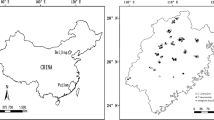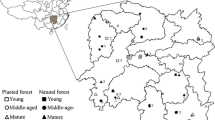Abstract
To better understand the effect of forest succession on carbon sequestration, we investigated carbon stock and allocation of evergreen broadleaf forest, a major zonal forest in subtropical China. We sought to quantify the carbon sequestration potential. We sampled four forest types, shrub (S R), pine (Pinus massoniana) forest (P F), pine and broadleaf mixed forest (M F) and evergreen broadleaf forest (B F). A regression equation was constructed using tree height and diameter at breast height (DBH) and elements of total tree biomass. The equation was subsequently utilized to estimate tree carbon storage. The carbon storage of understory, litter, and soil was also estimated. Carbon storage in biomass increased significantly from the early succession stage S R (6.21 t·ha−1) to the late stage B F (134.87 t·ha−1). The biomass carbon stock of forest layers generally increased with succession except for the understory. The soil organic carbon storage for the total profile increased with forest succession, from 51.16 to 90.49 t·ha−1, but the contribution of SOC to the carbon stock of the forest ecosystem declined from 89.18% to 40.15%. The carbon stock at ecosystem scale increased significantly with succession from S R (57.37 t·ha−1), to P F (154.20 t·ha−1), to M F (170.96 t·ha−1) and to B F (225.36 t·ha−1), with carbon stock of B F 3.93 times that of S R. The forests in our study have great potential for increasing carbon sequestration, and large areas of secondary or degraded evergreen broadleaf forests in the subtropical zone of China could be a great carbon sink in future.
Similar content being viewed by others
References
Dixon RK, Solomon AM, Brown S, Houghton RA, Trexier MC, Wisniewski J.1994. Carbon pools and flux of global forest ecosystems. Science, 263: 185–190.
Fang YT, MO JM, Peng SL, Li DJ. 2003. Role of forest succession on carbon sequestration of forest ecosystems in lower subtropical China. Acta Ecol Sin, 23(9): 1685–1694. (in Chinese).
FAO, 2006. Global forest resources assessment 2005-progress towards sustainable forest management. FAO Forestry Paper No. 147.
RomeFonseca W, Rey Benayas JM, Alice FE. 2011. Carbon accumulation in the biomass and soil of different aged secondary forests in the humid tropics of Costa Rica. For Ecol Manage, 262: 1400–1408.
Guo LB and Gifford, RM. 2002. Soil carbon stocks and land use change: a meta-analysis. Glob Chang Biol, 8: 345–360.
Houghton RA, Skole DL, Nobre CA. 2000. Annual fluxes of carbon from deforestation and regrowth in the Brazilian Amazon. Nature, 403(2000): 301–304.
Kelty MJ. 2006. The role of species mixtures in plantation forestry. For Ecol Manage, 233: 195–204.
Kong GH, Mo JM. 2002. Population dynamics of a human-impacted mason pine plantation in Dinghushan. J Trop Subtrop Bot, 10(3): 193–200.(in Chinese).
Lal R. 2005. Forest soils and carbon sequestration. For Ecol Manage, 20: 242–258.
Ma S, Li Z, Zhou B, Geri L, Kong W, An Y. 2010. Effects of Community Succession on Soil Organic Carbon in North Subtropical Area. Forestry Research, 23(6): 845–849. (in Chinese).
Mo JM, Sandra, B, Peng, SL, Kong GH, Zhang DQ, Zhang YC. 2002. Role of understory plants on nutrient cycling of a restoring degraded pine forests in a MAB reserve of subtropical China. Acta Ecol Sin, 22(9):1407–1413. (in Chinese).
Ouyang XJ, Huang ZI, Zhou GY. 2003. Accumulative effects of forest community succession on soil chemical properties in Dinghushan of tropical China. Journal of Soil and Water Conservation, 17(4): 51–54. (in Chinese).
Piao SL, Fang JY, Ciais P, Peylin P, Huang Y, Sitch S, Wang T. 2009. The carbon balance of terrestrial ecosystems in China. Nature, 458:1009–1013.
Scholes MC and Nowicki TE. 1998. Effects of pines on soil properties and processes. In: D.M. Richardson (ed.), Ecology and Biogeography of Pinus. UK: Cambridge Univ. Press, p. 341–353.
Wang KB, Chen ML. Qin J. 2007. Plant species diversity and the relation with soil properties in natural succession process in Ziwuling area. Acta Botanica Soreali-Occidentalia Sinica, 27(10): 2089–2096. (in Chinese).
Wang QK, Wang Sl, Deng SJ. 2005. Comparative study on active soil organic matter in Chinese fir plantation and native broad-leaved forest in subtropical China. Journal of Forestry Research, 16(1): 23–26.
Wang QK, Wang Sl, Huang Y. 2008. Comparisons of litterfall, litter decomposition and nutrient return in a monoculture Cunning hamialanceolata and a mixed stand in southern China. For Ecol Manage, 255: 1210–1218.
Wang QK, Wang Sl,, Zhang JW. 2009. Assessing the effects of vegetation types on carbon storage fifteen years after reforestation on a Chinese fir site. For Ecol Manage, 258: 1437–1441.
Wang SQ, Zhou CH, Li KR, Zhu SL, Huang FH. 2000. Analysis on spatial distribution characteristics of soil organic carbon reservoir in China. Acta Geogra Sin., 55(5): 533–544(in Chinese).
Wang XK and Feng ZW. 2000. The potential to sequester atmospheric carbon through forest ecosystem s in China. Chin J Ecol, 19(4): 72–74(in Chinese).
Xiao F, Fan S, Wang S, Xiong C, Zhang C, Liu S, Zhang J. 2007. Carbon storage and spatial distribution in Phyllostachy pubescens and Cunninghamia lanceolata plantation ecosystem. Acta Ecological Sinica, 27: 2801–2974 (in Chinese).
Zhang QF, Song YC, You WH. 1999. Relationship between plant community secondary succession and soil fertility in Tiantong, Zhejiang Province. Acta Ecologica Sinica, 19(2): 174–178. (in Chinese).
Zhou W, Guo M, Zhong Q, Wang XH, Yan ER. 2009. Characteristics of soil profile and organic carbon density among succession stages in the evergreen broad-leaved forests of Tiantong region, Zhejiang province. Journal of East China Normal University (Natural Science), 2: 11–20(in Chinese).
Zhou YR, Yu ZL, Zhao SD. 2000. Carbon storage and budget of major Chinese forest types. Acta Bota Sin, 24(5): 518–522. (in Chinese)
Author information
Authors and Affiliations
Corresponding author
Additional information
Fund project: This study was supported by the “Strategic Priority Research Program” of the Chinese Academy of Sciences (XDA05050205) and “International Science & Technology Cooperation Program of China (2012DFB30030)” and “Youth Innovation Fund of Hunan Academy of forestry” and the CFERN&GENE Award Funds for Ecological Papers.
Rights and permissions
About this article
Cite this article
Zeng, Zq., Wang, Sl., Zhang, Cm. et al. Carbon storage in evergreen broad-leaf forests in mid-subtropical region of China at four succession stages. Journal of Forestry Research 24, 677–682 (2013). https://doi.org/10.1007/s11676-013-0404-3
Received:
Accepted:
Published:
Issue Date:
DOI: https://doi.org/10.1007/s11676-013-0404-3




